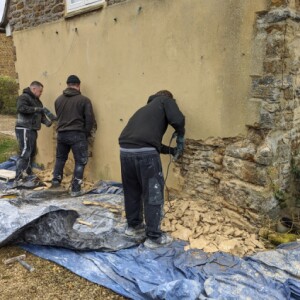Wall Story
Between about 200 and 180 million years ago, the Triassic age was just coming to an end and the Jurassic was just beginning. No surprise, then, that the age of the great reptiles was just dawning, the first ever flying vertebrates - pterodactyls - appeared and the first true mammals emerged. The supercontinent of Pangea, where all the land on the planet was concentrated, was just breaking up, and the pieces were beginning their long slow drift around the globe
The land that is now this part of Oxfordshire was under a shallow tropical sea, teeming with marine life. As they died, their skeletons and shells fell to the ocean floor, and became consolidated into an iron-rich, fossil-dotted sandy limestone that geologists now call 'marlstone', one of the 'Lias' group of rocks that cover much of the north of the county. Colloquially, around here it is just called 'ironstone', and it is this that was quarried during the 19th and 20th centuries for its iron content. But it has always also been used as a building stone - despite being relatively soft and friable - and that is what this is: the north wall of our house, built from rock roughly 180 million years old
It's looking a little dusty and rough because it has today been exposed to daylight for the first time for decades. Previous owners unwisely coated it with cement render, which traps moisture in the stone and can damage it. We have had it removed, and the wall will be made good (with breathable lime-based mortar) when the risk of heavy frosts has gone. When you are over 180 million years old, a couple of decades is the blink of an eye
The wall does tell a slightly more complicated story. The soft, rounded and rather flaky, honey-coloured (by iron componds) rock is pretty obvious. At the bottom (and elsewhere, when you get your eye in) are some more angular, harder-looking stones, grey coloured ("buff-coloured", according to the geologists). This rock is about 10 million years younger, formed when the sea was shallower and the sea bed was churned by wave action. All those skeletons and shells were washed to and fro, broken up and rolled around into tiny, spherical pieces called 'ooliths'
When these are compacted, they create a denser, harder limestone ('oolite'). It is still rich in iron, but with less oxygen in it, so the iron compounds have a different colour. It is commonplace to intermix the two types to give buildings greater strength and durability. Some of the buildings in the village deliberately intersperse layers of one type and then the other - dressed to create very distinct bands. We noticed in Cardigan that the Welsh do something similar with thick layers of slate in some buildings
Everything has a story


Comments
Sign in or get an account to comment.


